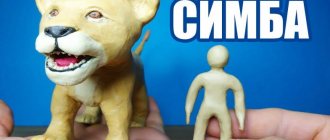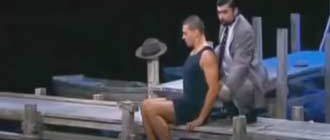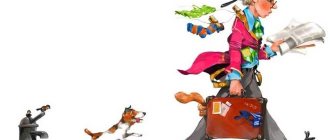On the topic: methodological developments, presentations and notes
Plan of drawing notes (preparatory group) on the topic: “Winter Landscape” using the non-traditional “Imprint” technique (drawing with vegetables).
Program content: Learn to draw rowan, highlighting the characteristic features of the bunch. Reinforce the idea of the color red; cultivate interest in collective creativity. Continue learning doat.
MBDOU "CRR - kindergarten "Bell" Summary of direct educational activities in drawing in the 1st junior group "Winnie the Pooh" Topic: "Wheels for the train" (non-trad.
summary of a drawing lesson in the junior group “Beasts in the Forest.”
Drawing outline for Cosmonaut Day using non-traditional drawing techniques.
Source
Project in kindergarten in the senior group on the topic: “Wardrobe”
Pedagogical project in the senior group on the topic “Wardrobe”
Description and purpose. This project will undoubtedly be of interest to kindergarten teachers. It reveals the work of introducing children to clothes and shoes. Problem: The children asked: “What types of fabrics are there and why are they different? And is it possible to create fabric with your own hands? What's inside the jacket? What kind of clothes and shoes are there? What are the names of...(parts of clothing, shoes)?” So, from a conversation with children and parents, it turned out that children do not have a general idea, or know something partially, about the origin and variety of clothing and its details, about the types of fabric. Relevance of the topic: knowledge about the variety of clothing, its details and types of fabric helps to enrich their knowledge about the world around them. The knowledge about wardrobe acquired in preschool childhood not only arouses in children a deep, sincere interest in it, but also encourages them to learn as much as possible about the properties of fabric, clothing made from it and its purpose. Analysis: what prevents you from getting results? What helps you achieve it? Duration of the project: short-term, implemented during the development of the topic (1 week). Type of project: educational - informational, productive. Project participants : children, parents, teachers. Children's age: 4-6 years. Project goal: To introduce children to wardrobe and become fashion designers to invent and create fabric, clothes and shoes in their creative activities. objectives :
To give children an idea of the variety of clothes and shoes.
Expand and deepen knowledge about fabrics. Activate children's vocabulary: names of fabrics, shoes, clothes and their parts. Developmental:
Develop thinking, memory, fine motor skills, coherent speech.
Develop creative abilities in productive activities. Develop curiosity and interest in your wardrobe. Educational
: Foster a caring attitude towards your wardrobe.
Develop the ability to come to the aid of each other. Promote interest in wardrobe. Hypothesis. Children will be interested in the history of the wardrobe. They will begin to ask adults questions and, together with them, seek answers to them. For the teacher: Give children knowledge about wardrobe. Develop curiosity and observation. Develop children's creative abilities. Expected result for children and parents: Showing interest and interest of children together with their parents to continue studying the history of the wardrobe. Increasing the level of knowledge of parents and children about wardrobe. Resource support. Equipment for the teacher: laptop, camera, tape recorder, television and video equipment, video and audio recordings, Internet. Equipment for children: books and illustrations of clothes and shoes, magnifying glasses, fabric samples, children's wardrobe. Product of project activity: • Drawing with colored pencils: “I am a fashion designer.”
• Corrective work “Stroke using templates” • Non-traditional drawing: “Passepartout (clothing)”. • Modeling “Slipper for a clown”. • Weaving from paper “Handkerchief” • Origami “Clothing. Sweater and trousers" Project implementation
Action plan
Stage 1 – organizational. 1. Talk with children about wardrobe. — What would you like to know about your clothes and shoes? - What do you already know? 2. Consultation for parents: “How to tell children about the wardrobe” 3. Excursion to the museum. On a weekend, invite parents and their children to take an excursion to the museum, especially to look at ancient clothing and a loom. Stage 2 - implementation of the project Within the framework of NOD Social and communicative development: conversation, role-playing game, board game, looking at illustrations, looking at children’s clothes in the area, word game. Cognitive development, FEMP: “How many pockets are there in your jacket?” and much more, didactic games, a story about the history of the wardrobe, games with counting sticks, experimental search activities. Speech development: writing stories based on your clothes and shoes, conversations about the variety of fabrics and wardrobe, reading fiction. Artistic and aesthetic development: appliqué, drawing, knitting and crocheting, paper design, paper folding using the origami method, unconventional drawing. Physical development: verbal games with a ball, outdoor games, finger games, breathing exercises. Stage 3 – summarizing Exhibition of crafts and drawings: • “I am a fashion designer”, • “Handkerchief for mom” • “Passepartout – clothes”
• “Clown Shoe”
Design of the group's gaming environment: • “Clothing Store”. • Collection of fabrics for examination and study through experimental methods. Processing and design of project materials in the form of a “Wardrobe” presentation. Results of the project: During the project, children became acquainted with the wardrobe, and their vocabulary expanded. A more sustained interest in fabrics, clothing and shoes appeared. Together with the teacher, we tried crocheting and knitting, got acquainted with the pattern of weaving threads to create fabric, wove scarves from paper strips, and together with our parents visited the museum of our city. We created our own models of clothes and shoes. Conducted research to determine the properties and quality of the material and its purpose. Particular attention was paid to the structure of the fabric. The children participated in the project with great pleasure, showing initiative and creativity in games and artistic and creative activities. Parents began to take more interest in the life of their children in the group, take initiative, and are happy to contribute to the educational environment. Literature. 1. A. Barto “Bear”.
I sewed a shirt for a bear... 2. K. Ushinsky “How the shirt grew in the field” 3. S. Mikhalkov “What do you have?” Application.
“What clothes do you know?” Goal: Learn to name a variety of clothes. Game actions: The leader throws the ball to the children and asks, and the children answer and return the ball to the leader. “Name the details of the clothing” Goal: Know and name the details of the clothing. Game actions: The leader throws the ball to the children and asks, and the children answer and return the ball to the leader. “What materials does the jacket consist of?” Purpose: name the materials of the jacket. Game actions: The leader throws the ball to the children and asks what materials the jacket is made of, and the children answer and return the ball to the leader. Game “Good - Bad”
Purpose: To improve children’s knowledge about fabric and wardrobe.
Game actions: The teacher or teacher offers children different situations, and the children make conclusions, for example: “Is summer clothes in the fall good or bad?”, “Is beautiful clothes good or bad?”, “Walking in sandals in the rain is bad or bad?” good?”, “Warm clothes in summer – is it good or bad?” Outdoor game “Loops go in circles” The teacher invites the children to play an interesting game. All children are little loops living in knitwear. They decided to go on a trip. (Children in pairs run like a snake, holding hands). The loops met and turned into rows. (The streams are connected into one chain.)
The rows met and became a large canvas.
(children form a round dance and move in a circle). "What changed?" Children's hats are placed in a row on the table. Children remember them. The teacher invites the children to close their eyes and removes one of the products. Children open their eyes and remember what has changed. The game is played 4-5 times. I wish you creative success! Thank you for your attention!
We recommend watching:
A project in a kindergarten for older preschoolers 5-7 years old on legal topics A project on the topic “Russian folk tales” in a kindergarten in the senior group A project in a kindergarten on the topic “Friendship”. Senior group Ecological and valeological project in kindergarten in the senior group
Similar articles:
Project for children of the senior group “Our cheerful garden”




